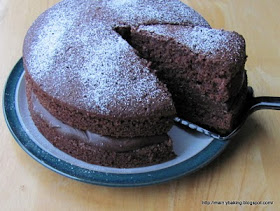I'm more excited about my new plate than I am about these cupcakes. Do you like it? I'm always on the look-out for pretty plates for my photographs but I don't very often see individual plates - even the charity shops usually sell sets, or part sets, which they don't want to split. So I was quite excited to find this Doulton tea plate from the 1930s, looking forlorn on a shelf, surrounded by unrelated bric-a-brac - not a matching cup in sight! I just couldn't leave it there, could I?
The cupcakes are a different matter. One look at the online recipe and photograph will pinpoint the main problem - the recipe says scoop out the cheesecake mixture; mine was pourable! In consequence, instead of the chocolate sponge rising round the cheesecake blob, the cheesecake spread over the top, and looked like a frosting when baked. The recipe is from the Hummingbird Bakery Cookbook, and it's the second recipe I've tried which has been disappointing.
The second potential problem, for me, was that the chocolate sponge base was one of those eggless mixtures, raised by the action of bicarbonate of soda on vinegar. I didn't realise this until I'd reached a point of no turning back, and I was quite worried, as the last time I made one of this type of cake it was so awful we had to throw it away! Happily, this batter rose nicely and didn't taste too bad - just a few random air-pockets to spoil a photograph!
Like Choclette, I had a problem with the consistency of the chocolate batter and had to add more water - about 30mls, which is quite a lot extra on 125mls. I also didn't bother with the frosting - it doesn't really fit in with lowering the fat content of things!
Although CT was happy to eat these, Hubs didn't like them, and I don't think I'll be making them again - or not from this recipe at least. I still like the idea of these, but would like to find a recipe which works better, and a reason why my cheesecake mixture turned liquid.











